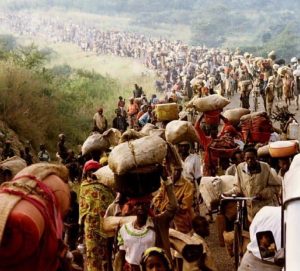24 But Thomas (who was called the Twin), one of the twelve, was not with them when Jesus came. 25 So the other disciples told him, “We have seen the Lord.” But he said to them, “Unless I see the mark of the nails in his hands, and put my finger in the mark of the nails and my hand in his side, I will not believe.”
26 A week later his disciples were again in the house, and Thomas was with them. Although the doors were shut, Jesus came and stood among them and said, “Peace be with you.” 27 Then he said to Thomas, “Put your finger here and see my hands. Reach out your hand and put it in my side. Do not doubt but believe.” 28 Thomas answered him, “My Lord and my God!” 29 Jesus said to him, “Have you believed because you have seen me? Blessed are those who have not seen and yet have come to believe.” [John 20:24-29, NRSV]
1. Coronavirus COVID-19; 2. 30-May-1994 Rwandan refugees crossing into Tanzania (Jeremiah Kamau, Reuters) to escape the genocide; 3. Mass grave for COVID-19 deaths, New York city.
In the COVID-19 international pandemic, a novel Coronavirus is ravaging the human body, taking heavy human casualties and wreaking deeply worrying economic havoc around the globe. But a microscopic virus is not the only culprit in the terrifying body-bags equation. Where their political goals are elsewhere-located than genuine concern for the people, self-serving politicians factor the economy of the body-politic over body bags. Money and ballots are higher calibrated than lives. Taking our reflection a short step further, one gets to the challenging question of complicity on the part of Christian churches wherever they fail scrutiny under the lens of human solidarity. Christian thinkers, both the deeply Christian ones and those who are nominally Christian, provide us with the contours of light and darkness along which we may tread.
1. The Incarnation Takes Up a Real Human Body
The Incarnation is about truly assuming the human body and the human nature.
Jesus of Nazareth was truly human and not only appeared to be human as the docetists claimed.
In Easter People: Living Community (Maryknoll, NY: Orbis Books, 2005), Cardinal Luis Antonio Tagle stresses the very concrete reality of the human body in the Incarnation. He writes:
- The Incarnation does not mean that Jesus simply assumed a human body. The assumption of the human body for Jesus meant that God became entangled in the mess called human existence. Jesus’ identification and solidarity with the human condition – its problems, longings, sufferings, failures, dreams, and hopes – is a missionary element of the Incarnation. The Incarnation of Jesus is a call to us to get involved in human beings.
This “call” to get to know – to get “involved in” – the suffering “body” is graphically portrayed in the Gospel story of the “doubting” Thomas in John 20:24-29. There, Thomas was invited to put his finger into the nailed hands and pierced side of the previously savaged and now raised body of Jesus. That invitation was necessary because Thomas would not and could not be a seriously believing and properly acting disciple following after the footsteps of Jesus the Suffering-Servant Messiah, unless and until he has touched – gotten involved in – the wounded body of the crucified and risen Lord. The deeper message demands our attention: clearly, we need to get into human wounds and human woundedness to be really involved in the vicissitudes of human existence. For the Easter people, to truly serve someone who suffers, to be truly in solidarity with them, our resurrection-practices in Christian ministry first requires of us to stay with their wounds. The post-resurrection Thomas-episode in John’s Gospel tells us not to avoid the wounds, nor run away from them. You come close to a person only if you come close to their wounds.
This is where Pope Francis is at his spiritual and pastoral best, insisting as he often does, that the Church of Christ must be like a field hospital attending to wounded bodies. This is where the Holy Father is coming from: he prefers a “church which is bruised, hurting and dirty because it has been out on the streets, rather than a church which is unhealthy from being confined and from clinging to its own security.” Christian ministers of all shades shall open their doors in order to go out to where the needs are, to serve the suffering and the wounded, to accompany them on their journey of life, listening to their stories and touching their wounds instead of being too quick to pronounce tough doctrines and harsh legal demands.
The minister, however, must go through a prior step. In The Wounded Healer: Ministry in Contemporary Society (New York: Image Books, 1990), Henri J.M. Nouwen provides the piercing insight that to authentically minister to wounded bodies requires of us to first get in touch with our own woundedness. This is closely connected to the resurrection message of “peace” Jesus gave his disciples. It is a message that says he understands their wounds and fears, but they can now move forward by embracing his presence, his truth, and his peace with which he blesses them. Nouwen clarifies his notion of “wounded healers”:
- Nobody escapes being wounded. We all are wounded people, whether physically, emotionally, mentally, or spiritually. The main question is not “How can we hide our wounds?” so we don’t have to be embarrassed, but “How can we put our woundedness in the service of others?” When our wounds cease to be a source of shame, and become a source of healing, we have become wounded healers.
“Jesus is God’s wounded healer,” he says, for “through his wounds we are healed. Jesus’ suffering and death brought joy and life. His humiliation brought glory; his rejection brought a community of love. As followers of Jesus we can also allow our wounds to bring healing to others.”
After resurrection, Jesus appeared to his disciples everywhere that they happened to be. In other words, he continued to be with and among them, just as he was before the crucifixion. After the Ascension, he sent them the Holy Spirit. In this way, he continued to be present among them and in the world, leading and inspiring them, working alongside them. After Pentecost, therefore, he became visibly present among his followers, but as the community of disciples. Quite literally from that time on, disciples of Jesus have become the Body of Christ. At the Incarnation, Jesus became the human face of God. From the first Pentecost, the disciples became the human face of Christ. The only face of Christ visible to the world is the face of the Church, the community of disciples, the Body of Christ. How that Body behaves is all that the world shall see of the Christ and shall base their evaluation of the Christian faith on.
2. A Literally Insane Easter Season of Bodies
Easter is about Resurrection of the Body.
Resurrection is the work of God, who raised Jesus from death to new life. It is not the resuscitation of a dead corpse.
In Mirror to the Church: Resurrecting Faith after Genocide in Rwanda (Grand Rapids, MI: Zondervan, 2009), Emmanuel Katongole, a Ugandan Catholic Priest and a tenured professor at Notre Dame University in the USA, offers a powerful analysis of the Rwandan Genocide. The genocide captured world attention for its mind-numbing scale of insane slaughter of human bodies, some one million or so within a 100-day mad rampage. Evil ran deep. Exactly one week before the command to kill was given, on Maundy Thursday (“Maundy” comes from the Latin Mandatum which means command), Christians in Rwanda gathered in church to listen, recall and remember from Scriptures, how Jesus gathered with his disciples in the Upper Room, washed their feet, shared a meal, and gave them a new command that would change the face of the earth, to:
- “Love one another. As I have loved you, so you must love one another. By this everyone will know that you are my disciples, if you love one another” (John 13:34-35). Three times, the Lord commanded the disciples to love.
That the insane slaughter of human bodies by professed Christians began on the Thursday of Easter week 1994, in a country that was more than 85% Christian, that European missionaries bragged as a missionary success and a model of evangelization in Africa, raised urgent questions of costly and cheap faith. Madness reigned over genocidal decisions. To settle ethnic differences (see Katongole’s detailed historical analyses), one million or so Rwandan bodies were wantonly “hacked to pieces”, mostly by machetes. In the darkness of the night, as always, the starkest of betrayals began. Christians killed Christians during the Easter Week. One half of the Body of Christ slaughtered the other half. Blood was thicker than the water of baptism!
Shrouded under a Rwandan “Easter season of bodies”, Christians of all shades, Katongole insists, are called to critical examination of what Christianity is all about, what authentic missionary and evangelization work ought to be, and what kind of a face of Christ do we portray to the world. Rwanda has put Christianity on trial. The Church which Christ left behind failed scrutiny. Shame.
Katongole does not mince his words:
- “The tragedy in Rwanda is also a mirror reflecting the deep brokenness of the church.”
- “Rwanda brings us to a cry of lament on our knees where together we learn that we must interrupt these patterns of brokenness.”
To properly use Rwanda as mirror, to lament on our knees, and to interrupt all these patterns of brokenness, encounter with the Crucified and Risen Christ has got to be the key. Resurrection is nothing, if it is not about a new creation and about hope. For Easter is concerned not only with recalling the resurrection of Jesus and the impact on his disciples, but also with the meaning of Easter for our faith and our lives today and every day. The one thing that all those Gospel accounts of encounters with the Risen Lord have in common is that they are always life-giving:
- the Lord comes through lockdowns to bring peace that overcomes paralyzing fear;
- he forgives the disciples and commissions them anew;
- he empowers them with gifts from on high;
- he wants them to build and share loving relationships and to empower humble service to the community, mindful always of the needy.
Both the 1994 Rwanda Genocide and COVID-19 pandemic are Easter events. We who are blessed because we “have not seen and yet believe,” shall be particularly mindful of those in need of our material and emotional support, our protection from injustice and intolerance. Truly, this time of Coronavirus is an ideal time to be the face of the Risen One, to be a sign of hope and compassion, tolerance and mercy. This is the opportune time to be a true sign that we are the Body of Christ saving bodies instead of being callous about body-bags.
3. Saving Bodies vs. Saving the Economy
The right to life is the most basic of human rights.
The term “pro-life” suggests life-saving and life-guarding, which enjoys strong endorsement by Christian groups across the denominations that decry abortion rights and the related “pro-choice”. It is scarcely surprising that many American politicians would ostensibly throw their weights behind pro-life Christian churches and groups, posturing as they do behind their ballot boxes. But merely carrying a slogan says little about the contents of one’s actions. Trump, ostensibly pro-life, is a classic case in point. This is awfully clear in his eagerness to open businesses in America even as the country is in the grips of the COVID-19 crisis. With both his family businesses and his ballot box under severe threat so long as economic activities are under lockdown, Trump has openly declared that he would rather see more American deaths than continue the halt on economy. He would waive all considerations on body-bags, just so businesses could reopen. Acting as the imperium in imperio (the supreme and soverign head in a so-called democratic government), he would sacrifice bodies for money and ballots. This is self-serving to the extreme, the very anti-thesis of “pro-life”. He would sacrifice American bodies for political gains, purely for personal ambition. A raw power play for political control, Trump manifests himself as a ruthlessly self-serving and untrustworthy leader. He is anything but pro-life.
In this, he pales miserably in comparison with his counterpart Xi Jinping in the communist government of China. We see here an element of surprise which characterises the Easter story. Just as Christians would expect a “Christian” response from a so-called Christian country like the USA, and its so-called Christian “pro-life” leader Trump, what we get is a callous preferential option for the body-bags, so long as businesses can open at once. And, surprise, from a communist government which Western propaganda has all but dismissed as “authoritarian” and “evil”, what we get is a perfectly Christian response. The truly Easter response is found in unexpected places, in this case, from the so-called non-believing, non-Christian, Communist China. The reason, as Professor Martin Jacques of Cambridge University puts it: “The Chinese government understood that life came before the economy.” Or, as a Chinese lady commenting on her people tenaciously pulling their weight to save lives and to put a lid on the curve of infection writes: “The Chinese people cherish and protect lives, which is a manifestation of the beauty of human nature.” Throughout the time since the novel Coronavirus first exploded in Wuhan, the driving spirit and operative principle of China, in keeping with her socialist concerns for the people, is first and foremost to save lives at all costs. When lives are at stake, nothing matters more than saving lives. Pro-life is not a cheap slogan. Pro-life in the Chinese socialist system is not shouted from the rooftops, but lived and enacted, and evidence-attested through sweat and toil, blood and tears, and much untold sacrifices. In the socialist system, life is sacred. You do not look to saving the financial capital first; the people are your capital. You knuckle down and save human bodies for all you can. There’s nothing more important than that. You save lives. You make your contribution to the larger good. That’s pro-life, in substance and in truth.
Why do we see this distorted picture – a so-called Christian democratic nation like the USA behaving in a blatantly unchristian fashion, and a supposedly non-Christian Communist nation upholding values that are gloriously Christian? Perhaps the writings of Karl Rahner, SJ, the preeminent Catholic theologian of the 20th century may throw some light. He takes us back to our first quote from Tagle. In his extensive writings on the Incarnation, Rahner said that God can and must be “experienced” in the living reality all around us whether it be in a supposedly Christian democratic nation or a supposedly non-Christian Communist nation. Catholics, for instance, have been socialized into believing that “temple worship” (read “Holy Mass”) is what is most essential, and that their spirituality and religious duties can best be (even “only be”?) exercised within the confines of sacred spaces and with holy things. Rahner corrected that view. Christians in a largely secularized world, he explained, have to find their union with God, not in places and things that traditional religion marks out as “sacred”, but in that which it abhors as “mundane”. With the Incarnation, nothing is merely “mundane”. Rather, the whole of the created reality is infused with transcendence, precisely because of the Incarnation of God in the person of Jesus the Christ.
Sadly today, economics has come to dominate our world instead of basic human rights. Pope Francis has strong words to say in this regard. During Mass on Easter Monday (13 April 2020), the Holy Father urged governments, scientists and politicians to find solutions to the COVID-19 crisis in consideration of the people. They discharge their duties, he said, only if they choose the life of the people over the god of money. The Holy Father recalled Christ’s warning that one cannot serve both the Lord God and the lord of money. To choose money over people’s lives is to be callous about body bags. That, to the Holy Father, is to fail to bet on the resurrection of the people and on the God of life, but instead to bet on the god of money and to fall back into the tomb where only the body of the dead lies.
Copyright © Dr. Jeffrey & Angie Goh, April 2020. All rights reserved.
You are most welcome to respond to this post. Email your comments to jeffangiegoh@gmail.com. You can also be dialogue partners in this Ephphatha Coffee-Corner Ministry by sending us questions for discussion.



